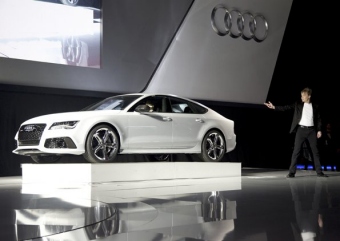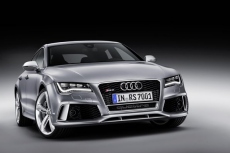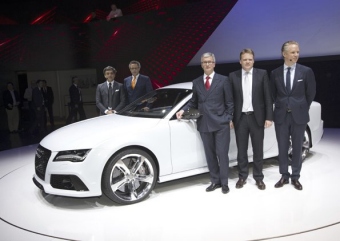
Automotive Intelligence - the web for automotive professionals and car enthusiasts
January 2013
-
BMW 4 Series Concept Coupé Makes World Debut in Detroit 2013
-
Global Debut for the Bentley GT Speed Convertible, world’s fastest four-seat convertible
-
Honda’s “Urban SUV Concept” Makes its World Debut at the 2013 North American International Auto Show
-
The Audi RS 7 Sportback made its debut at the North American International Auto Show 2013
-
World premiere of the Volkswagen CrossBlue Concept Car in Detroit
-
Kia Motors America Announces North American Debut Of The 2014 Cadenza
-
Cadillac unveiled the 2014 ELR at the North American International Auto Show
-
Nissan Debuts 2014 Versa Note, Resonance Crossover Concept At North American International Auto Show
-
Most Powerful Rolls-Royce In History Debuts At Geneva Motor Show
-
BMW Group and Toyota Motor Corporation Deepen Collaboration by Signing Binding Agreements
-
Volkswagen Passenger Cars delivers 5.74 million vehicles in 2012
© 1998 - 2013
Copyright &
Disclaimer
Automotive Intelligence,
www.autointell.com
All Rights Reserved .
For questions please contact
editor@autointell.net
|
The Audi RS 7 Sportback made its debut at the North American International Auto Show 2013
Detroit - Audi is expanding its RS model lineup: The RS 7 Sportback, which is making its debut at the North American International Auto Show 2013 in Detroit, stands for dynamics at their most beautiful. The large five-door coupe uses a 4.0 TFSI engine producing 412 kW (560 hp). The sprint from zero to 100 km/h (62.14 mph) takes just 3.9 seconds, and the speed governor can be deactivated upon customer request to permit a top speed of up to 305 km/h (189.52 mph). Despite this superior performance, the Audi RS 7 Sportback consumes on average just 9.8 liters of fuel per 100 km (24.00 US mpg). Aesthetic design, innovative technology and impressive sportiness: The RS 7 Sportback, the large five-door coupe from Audi, combines many strengths to produce a fascinating character. Its strong heart is the 4.0 TFSI, which takes Audi’s downsizing strategy to the high-end category. The twin-turbo V8 displaces 3,993 cc and develops awesome power, with 412 kW (560 hp) available between 5,700 and 6,700 rpm. A constant 700 Nm (516.29 lb-ft) of torque are available between 1,750 and 5,500 rpm.
|
|
|
|
|
|
Because the high-revving four-liter engine has been rigorously designed for low load-change and flow losses, it develops this power quickly and spontaneously. The cylinder heads have the exhaust side on the inside and the intake side on the outside. The two twin-scroll turbochargers, which produce up to 1.2 bars of relative boost pressure, are located together with the intercooler in the inside V of the cylinder banks. Consequently, the gas paths are very short and response very good. The RS-specific engine management and unthrottled intake system also contribute to the dynamic character of the twin-turbo V8. Switchable flaps in the exhaust system make the engine sound even fuller at the push of a button or under strong acceleration. Audi also offers an optional sport exhaust system. The RS 7 Sportback sprints from 0 to 100 km/h (62.14 mph) in just 3.9 seconds. Audi limits the top speed in the standard configuration to 250 km/h (155.34 mph). Top speed with the optional dynamic package is 280 km/h (173.98 mph) and 305 km/h (189.52 mph) with the dynamic package plus. Yet the new top model of the model series consumes on average just 9.8 liters of fuel per 100 km (24.00 US mpg). This top value is due in part to the standard start-stop system and innovative thermal management. |
|
The most innovative efficiency technology in the new Audi RS 7 Sportback is the cylinder on demand (COD) system. At low to medium loads and engine speeds, it deactivates cylinders 2, 3, 5 and 8 by closing their valves via electromechanical actuators. The 4.0 TFSI then runs as a four-cylinder engine until the driver accelerates more strongly again. The operating points in the active cylinders are displaced toward higher loads, increasing efficiency.
All of these operations take just a few hundredths of a second and occur so smoothly and quickly that they can hardly be felt or heard. Active engine bearings, another high-end solution from Audi, use out-of-phase counter-oscillations to compensate for the slight vibrations that occur during four-cylinder operation. The COD technology reduces NEDC fuel consumption by roughly five percent, and even greater savings of approximately 10 percent are possible when driving at moderate speeds.
The standard eight-speed tiptronic is specially tuned to the sporty character of the Audi RS 7 Sportback. Drivers can choose between the modes D and S or change gears themselves using the shift paddles on the steering wheel or the selector lever, which sports a unique RS design. While the lower gears of the tiptronic are closely spaced for sporty response, eighth gear is tall like an overdrive to reduce fuel consumption.
The Audi RS 7 Sportback comes standard with quattro permanent all-wheel drive for its decisive advantage in traction and driving safety compared with its two-wheel-drive competitors. At the heart of the quattro system is a center differential with a high locking rate and a separate oil cooler to regulate its temperature. It distributes the power as needed within a wide range between the front and rear axles. In the standard configuration, 60 percent flows to the rear and 40 percent to the front.
Photos: Audi
(Jan. 14, 2013)


